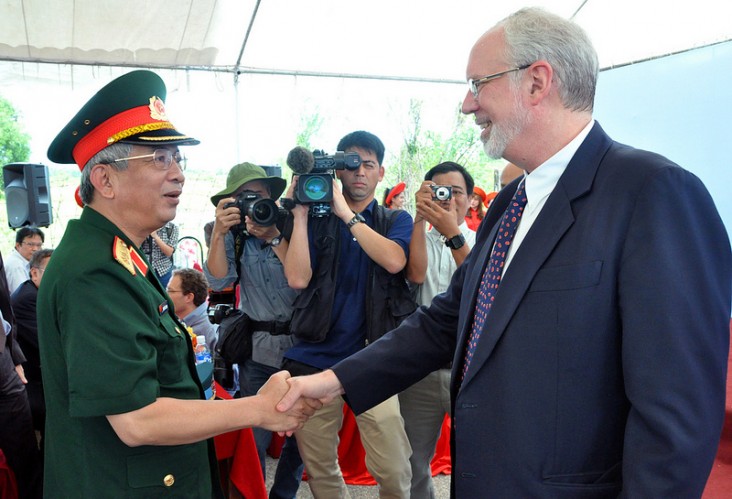
DANANG -- This morning we celebrate a historic milestone for our bilateral relationship.
Today's ceremony marks the start of a project between Vietnam's Ministry of National Defense and the U.S. Agency for International Development, USAID, to clean up dioxin contaminated soil and sediment at the airport left from the Vietnam War. Over the next few years, workers will dig up the contaminated soil and sediment and place it in a stockpile, where it will be treated using thermal desorption technology. This process uses high temperatures to break down the dioxin in the contaminated soil and make it safe by Vietnamese and U.S. standards for the many men, women, and children who live and work in this area.
We have worked together closely over many years in a spirit of mutual respect and cooperation to reach this point. With Presidential and Congressional support from Washington, my Embassy has cooperated with the Ministry of Natural Resources and Environment's Office 33 since its establishment in 1999 to coordinate Vietnam's policies and programs on Agent Orange. We've used annual meetings of the Joint Advisory Committee under the leadership of Office 33 and the U.S. Environmental Protection Agency to seek science-based solutions to complex environmental and health issues related to Agent Orange.
As part of Vietnam's contribution to the cleanup, the Ministry of National Defense cleared unexploded ordnance from the airport site and will construct a power substation to supply electricity for the remediation process. We also greatly appreciate the strong commitment of other partners, including the Danang People's Committee and Airport Authorities, to the success of this project.
But it's not governments doing this alone. The Ford Foundation supported early research to identify dioxin hotspots in Vietnam and contain dioxin contamination at the Airport. With assistance from the U.S. Government, they also worked with Office 33 to craft interim measures to reduce dioxin exposure pending the full-scale, permanent cleanup.
The Bill and Melinda Gates Foundation and Atlantic Philanthropies also financed a $6 million laboratory that provides Vietnam with high-resolution dioxin analysis capability. From 2008 to 2012, three USAID partners -- the East Meets West Foundation, Save the Children, and Vietnam Assistance for the Handicapped -- provided medical, rehabilitation, employment, and educational support for 11,000 people in Danang living with disabilities, regardless of cause.
There's a lot of expertise present here today to make sure this job gets done right. Our partners will bring the same commitment to health and safety that they have deployed on many other successful environmental remediation projects around the world. They will help create a safer and cleaner environment for the people who live in this vibrant and rapidly developing area.
Even as we launch this important project, we look forward to doing more. By the end of September, USAID will have started a new health and disability program to support people with disabilities, regardless of cause, in Danang and other locations. We are also preparing for an environmental assessment of the Bien Hoa hotspot in coordination with the Vietnamese Government, UNDP, and other donors.
But for now, let's simply celebrate the success which brings us together this morning. As Secretary of State Hillary Clinton remarked while visiting Vietnam in October 2010, the dioxin in the ground here is "a legacy of the painful past we share," but the project we undertake here today, hand-in-hand with the Vietnamese, is "a sign of the hopeful future we are building together." We are both moving earth and taking the first steps to bury the legacies of our past. I look forward to even more successes to follow.
Thank you.







Comment
Make a general inquiry or suggest an improvement.